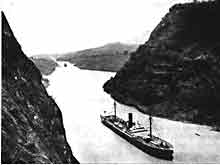Related Links
Famous Ship CanalsRepublic of PanamaThe Panama Canal Web Site
U.S. engineers organized thousands of workers for the 10-year project that would eventually become one of the greatest engineering achievements in history. The United States government owned and operated the canal and the surrounding zone for 85 years, establishing it as a valuable trade route and important piece of national security for its armed forces. During World War II the U.S. population in Panama included 65,000 soldiers plus tens of thousands of civilian employees.
Source of Bad Relations
The canal gradually became a source of bad relations. Anti-U.S. riots in the 1960s sparked negotiations for a new treaty. On Sept. 1, 1977, after a one-vote victory in the Senate, President Carter signed the Panama Canal Treaties. The legislation called for the step-by-step transfer of the canal to the government of Panama beginning on Oct. 1, 1979, and officially ending on Dec. 31, 1999. Between 1979 and 1999, a U.S. government agency called the Panama Canal Commission, made up of five Americans and four Panamanians, supervised the transition. On Dec. 31, 1999, the U.S. honored a 22-year-old treaty and handed the canal—and the responsibilities that come with it— to the Republic of Panama. The new Panama Canal Authority assumed responsibility for the canal.
What Happens Next?
Some wonder if the canal transfer was a mistake. To many Americans, the Panama Canal symbolizes a key piece of the nation’s economic and millitary success. After all, Panama is a country slightly smaller than South Carolina and it has no military. The state department says the hand-over of the canal was a gesture of American confidence in the Panamanians. Officials claim the land essentially belongs to Panama and all of Latin America.
